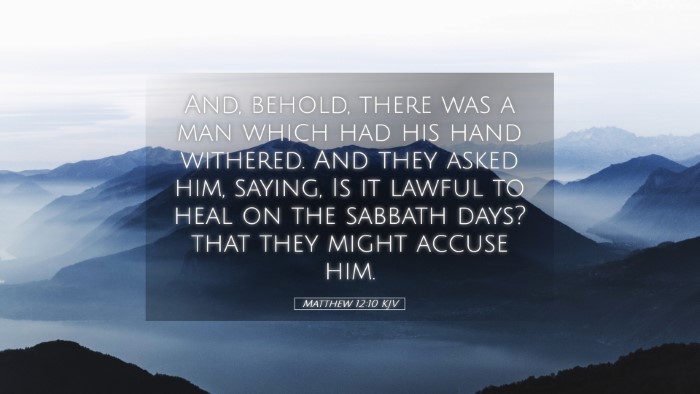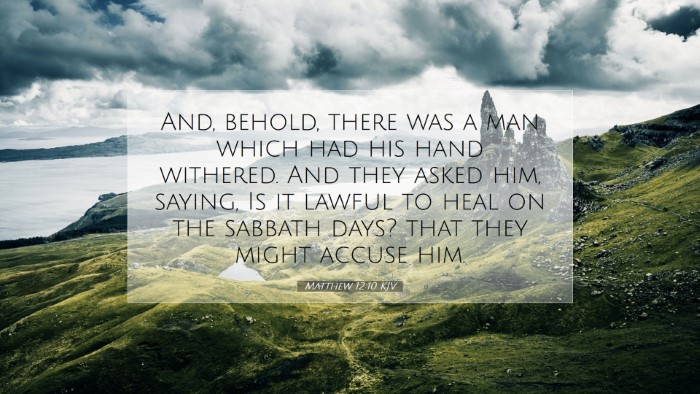Bible Commentary on Matthew 12:10
Text of Matthew 12:10: "And behold, there was a man which had his hand withered. And they asked him, saying, Is it lawful to heal on the sabbath days? that they might accuse him."
Contextual Background
The Gospel of Matthew often emphasizes the conflict between Jesus and the Pharisees, particularly regarding the interpretation of the Law. In this passage, we see a vivid example of how religious leaders would test Jesus, seeking to find fault in His actions on the Sabbath.
Commentary Insights
1. The Condition of the Man
Matthew Henry observes that the man with the withered hand represents those who are suffering and in need of healing. His condition is not merely physical; it symbolizes spiritual and moral disabilities that afflict humanity. In coming to Jesus, he embodies the desperate state of mankind, seeking restoration and wholeness.
2. The Legalism of the Pharisees
Albert Barnes notes that the Pharisees' question highlights their legalistic approach to the Sabbath. They believed that any work, including healing, on the Sabbath was a violation of the Law. This reflects a broader theme in Scripture where human traditions often eclipse the spirit of the Law. The Pharisees sought not only to trap Jesus but also to enforce a rigid interpretation of the Law that neglected compassion and mercy.
3. Jesus' Response and Teaching
Adam Clarke emphasizes Jesus' teaching methodology in this scenario. Instead of directly answering their trick question, He poses a probing question: "What man shall there be among you, that shall have one sheep, and if it fall into a pit on the sabbath day, will he not lay hold on it, and lift it out?" (v. 11). This rhetorical question serves to illustrate the principle of mercy over legalism and the inherent value of human beings, justifying His act of healing on the Sabbath.
4. The Healing Miracle
Matthew Henry reflects on the healing that takes place as an act of divine authority. Jesus demonstrates that He is Lord of the Sabbath (Matthew 12:8) and, thus, has the power to interpret the Law correctly. The act of healing not only restores the man physically but also elevates the understanding of the Sabbath from mere prohibition to a day of mercy and service.
5. Implications for Today
In examining this passage, we are reminded of the importance of compassion and the need to prioritize human welfare over rigid adherence to rules. This lesson is crucial for pastors and theologians today, as they navigate issues of legalism in contemporary religious practices.
- Merit of Human Life: The value placed on a man's life over ritual observance stands as a powerful reminder for the church to focus on grace and mercy.
- Understanding the Sabbath: The Sabbath should be a time for restoration, both physically and spiritually, reflecting God’s love and concern for humanity.
- Spirit of the Law: This passage encourages a deeper examination of the intent behind the Law. Are we upholding the spirit of the Law in our communities or merely following rules?
Conclusion
This encounter between Jesus and the Pharisees not only highlights the tension between legalism and compassion but also provides profound insights into the nature of Christ's ministry. For modern readers, including pastors and scholars, the lessons drawn from this passage serve as an enduring challenge to prioritize grace over the law, reflecting the true heart of God.


